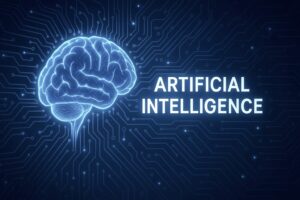Artificial Intelligence (AI) is not just the future—it’s the present. From self-driving cars to AI-powered assistants, the technology is transforming industries. Whether you’re a student, software developer, or curious enthusiast, this guide will help you navigate the AI landscape with a clear, structured roa

1. Understand the Foundations
Before diving into AI, build a solid foundation in these core areas:
Mathematics
-
Linear Algebra: Vectors, matrices, eigenvalues
-
Probability & Statistics: Bayes theorem, distributions, hypothesis testing
-
Calculus: Gradients, derivatives, optimization
-
Discrete Math (optional): Useful in algorithms and logic
Programming
-
Language: Start with Python (most widely used in AI)
-
Key Libraries: NumPy, Pandas, Matplotlib, Scikit-learn
Tools & Platforms
-
Jupyter Notebook
-
Google Colab
-
Git & GitHub
2. Learn Core Machine Learning (ML)
Machine Learning is the backbone of AI. Here’s what to focus on:
Supervised Learning
-
Regression, Classification
-
Algorithms: Linear Regression, Decision Trees, SVM, KNN
Unsupervised Learning
-
Clustering, Dimensionality Reduction
-
Algorithms: K-means, PCA, DBSCAN
Evaluation Metrics
-
Accuracy, Precision, Recall, F1-Score, Confusion Matrix
Model Selection & Tuning
-
Cross-validation
-
Grid Search & Random Search
Resources:
-
Andrew Ng’s ML course (Coursera)
-
Hands-On ML with Scikit-Learn & TensorFlow by Aurélien Géron
3. Deep Dive into Deep Learning
Deep Learning models neural networks that mimic human brain structure.
Core Concepts
-
Perceptrons, Activation Functions
-
Forward & Backpropagation
-
Loss Functions and Optimizers (SGD, Adam)
Neural Networks
-
Feedforward Neural Networks
-
Convolutional Neural Networks (CNNs) – for image data
-
Recurrent Neural Networks (RNNs) – for sequential data
Popular Frameworks
-
TensorFlow
-
PyTorch
-
Keras
4. Explore Specialized AI Domains
Once comfortable with ML/DL, branch into these areas:
Natural Language Processing (NLP)
-
Tokenization, Word Embeddings (Word2Vec, GloVe)
-
Transformers, BERT, GPT models
-
Applications: Chatbots, Text Summarization, Translation
Computer Vision
-
Image Classification, Object Detection (YOLO, Faster R-CNN)
-
Image Generation (GANs, Diffusion models)
Reinforcement Learning
-
Markov Decision Processes (MDPs)
-
Q-Learning, Policy Gradients, Deep Q Networks (DQNs)
Ethics & Responsible AI
-
Bias & Fairness
-
Explainability (SHAP, LIME)
-
Privacy & Model Robustness
5. Real-World Practice & Projects
Kaggle & Competitions
-
Participate in Kaggle competitions to test your skills
Capstone Projects
-
Examples: Fake news detection, Image captioning, AI-powered recommendation systems
Build a Portfolio
-
Host projects on GitHub
-
Write blog posts or tutorials
6. Stay Up-to-Date & Network
Follow AI Trends
-
Read papers on arXiv or Google Scholar
-
Stay active on Medium, Towards Data Science, Reddit
Join Communities
-
LinkedIn groups, Discord servers, local AI meetups
-
Attend conferences: NeurIPS, CVPR, ICML
7. Optional but Powerful: Learn MLOps
Production & Deployment
-
Docker, Flask/FastAPI, CI/CD pipelines
Model Monitoring
-
MLflow, DVC, Kubeflow
Final Thoughts
Learning AI is a marathon, not a sprint. Stay curious, be consistent, and keep building. The field is vast and evolving—there’s always something new to learn.
Remember: Projects > Courses. Theory is critical, but implementation builds mastery.
Disclaimer
The information contained in this post is for general information purposes only. The information is provided by The Complete Roadmap to Mastering Artificial Intelligence in 2025 and while we endeavour to keep the information up to date and correct, we make no representations or warranties of any kind, express or implied, about the completeness, accuracy, reliability, suitability or availability with respect to the website or the information, products, services, or related graphics contained on the post for any purpose.